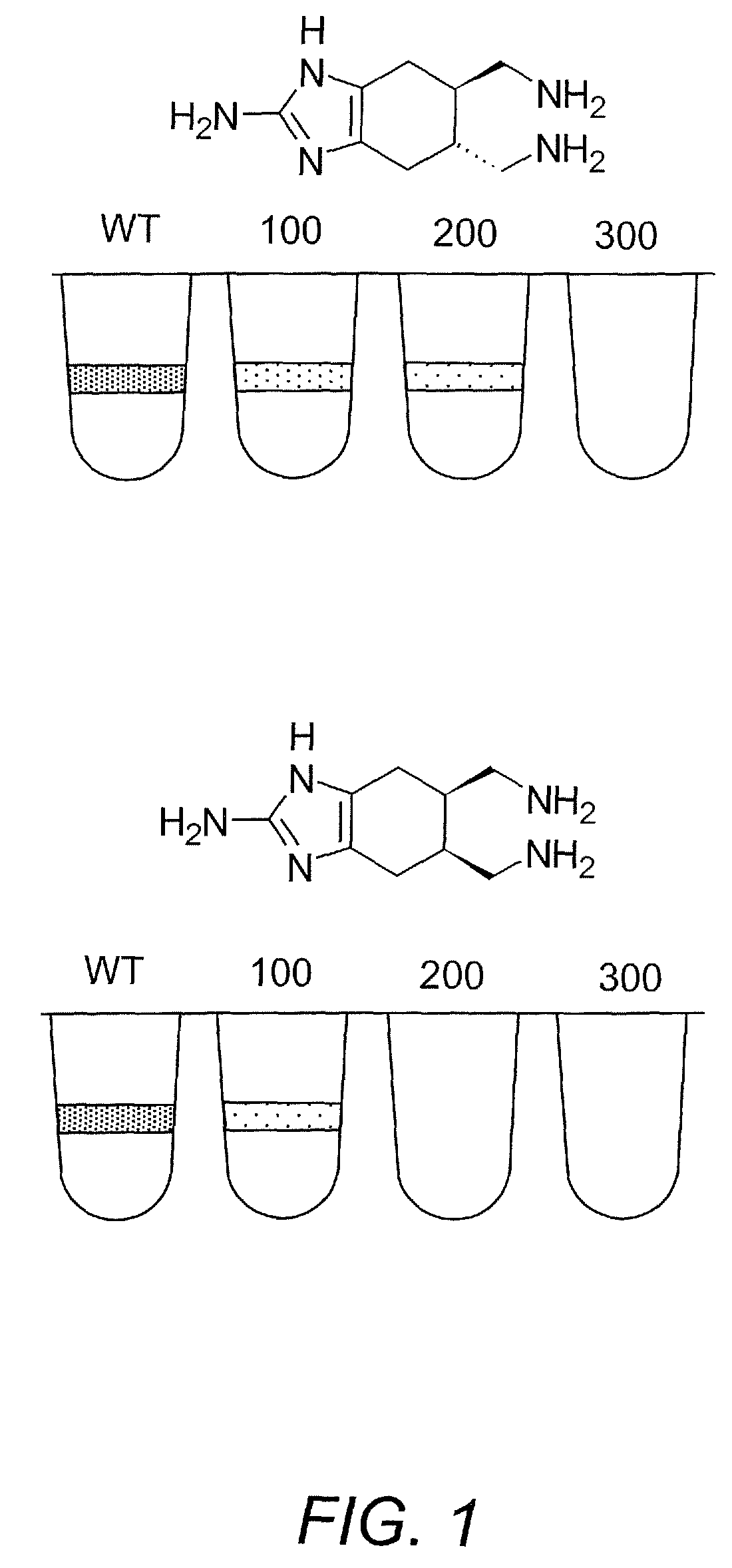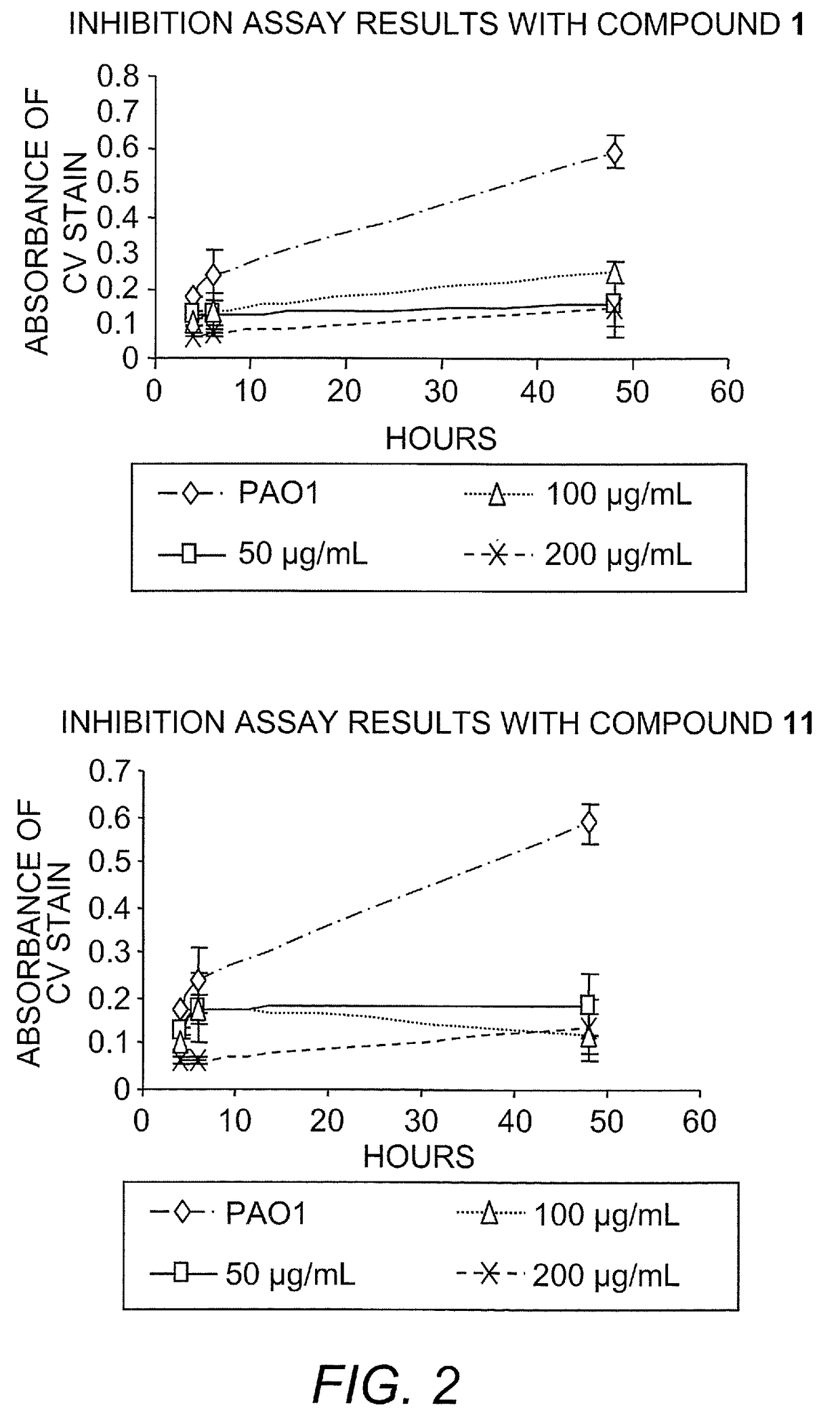Inhibition of bacterial biofilms with imidazole derivatives
a technology of imidazole and biofilm, which is applied in the field of inhibiting bacterial biofilms with imidazole derivatives, can solve the problems of inability to eradicate bacterial colonization, inability to prevent infection of indwelling medical devices, and inability to prevent infection of indwelling patients, etc., and achieve the effect of preventing, inhibiting or removing a biofilm, and preventing, reducing or inhibiting i
- Summary
- Abstract
- Description
- Claims
- Application Information
AI Technical Summary
Benefits of technology
Problems solved by technology
Method used
Image
Examples
example 1
[0353]Inhibition of Pseudomonas aeruginosa biofilm formation. A compound of Formula (II)(a)(i) (“compound 1”) was synthesized in 10 linear steps, outlined in Scheme 1. Diethyl fumarate and 1,3-butadiene were subjected to a [4+2] cycloaddition to yield the Diels-Alder adduct 2. The diester 2 was then reduced with lithium aluminum hydride (LiAlH4) to yield diol 3. The diol was then treated with mesityl chloride (MsCl) to generate the corresponding bis-mesylate 4 that was then refluxed with sodium azide (NaN3) to yield di-azide 5. We then epoxidized 5 with meta-chloroperoxybenzoic acid (m-CPBA) at room temperature in the absence of ambient light to generate 6. Epoxide 6 was then treated with NaN3 and sulfuric acid H2SO4 in refluxing ethanol to yield the azidoalcohol 7 that was subsequently subjected to hydrogenating conditions in the presence of di-tert-butyl dicarbonate (Boc2O). The tri-Boc protected amino alcohol 8 was then oxidized with pyridinium chlorochromate to generate ketone 9...
example 2
[0360]Active compounds were tested for inhibition of biofilm formation using various bacterial strains. Results are reported in TABLE 1. Assays were performed as reported above, with 500 μM active compound, and 24 hours. “X” denotes biofilm inhibition.
[0361]
TABLE 1FormulaCompoundP. aeruginosaV. VulnificusH. Pacifica(II)(a)X(II)(a)XXX(I)(a)(i)XX(I)(a)(iv)XX(I)(a)(xviii)XX(I)(a)(xviii)X(I)(a)(xviii)X(V)X(I)X
example 3
[0362]Identification of a bicyclic 2-aminoimidazole derivatives that inhibit and disperse bacterial biofilms. In Example 1 above it was demonstrated the synthesis of a small molecule, denoted TAGE (trans-bromoageliferin analogue), based on the natural product bromoageliferin, and demonstrated that TAGE had anti-biofilm activity against Pseudomonas aeruginosa (see FIG. 4). It is demonstrated by the present Example that TAGE: 1) does not have selective toxicity against cells within the biofilm state, 2) will inhibit biofilm development under flow conditions, indicating that the CV staining protocol correlates with the ability to be active under biomimetic conditions, and 3) TAGE will disperse preformed P. aeruginosa biofilms. It is also demonstrated that TAGE is not cytotoxic. Further analogue development (see FIG. 4) has identified compounds that are exceedingly effective as biofilm inhibitors against the γ-proteobacteria in this study (PAO1, PA14, PDO300, and A. baumannii). Against ...
PUM
| Property | Measurement | Unit |
|---|---|---|
| pH | aaaaa | aaaaa |
| concentration | aaaaa | aaaaa |
| particle size | aaaaa | aaaaa |
Abstract
Description
Claims
Application Information
 Login to View More
Login to View More - R&D
- Intellectual Property
- Life Sciences
- Materials
- Tech Scout
- Unparalleled Data Quality
- Higher Quality Content
- 60% Fewer Hallucinations
Browse by: Latest US Patents, China's latest patents, Technical Efficacy Thesaurus, Application Domain, Technology Topic, Popular Technical Reports.
© 2025 PatSnap. All rights reserved.Legal|Privacy policy|Modern Slavery Act Transparency Statement|Sitemap|About US| Contact US: help@patsnap.com



